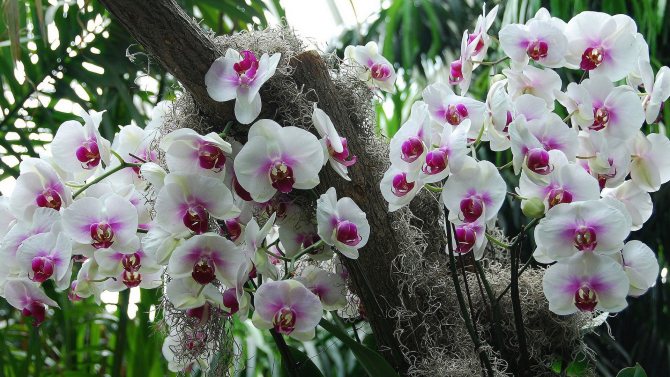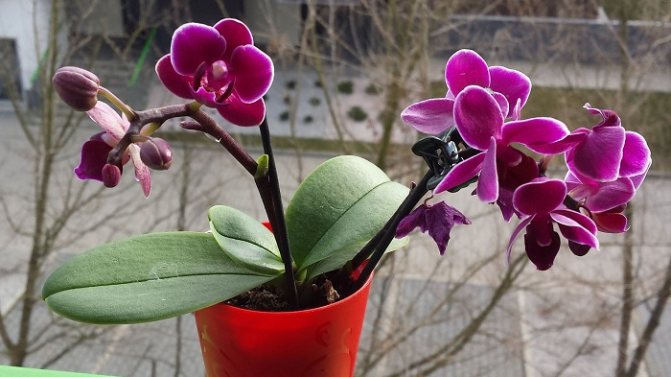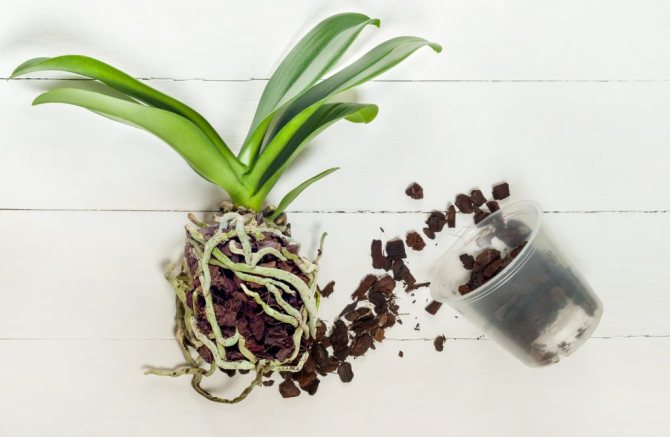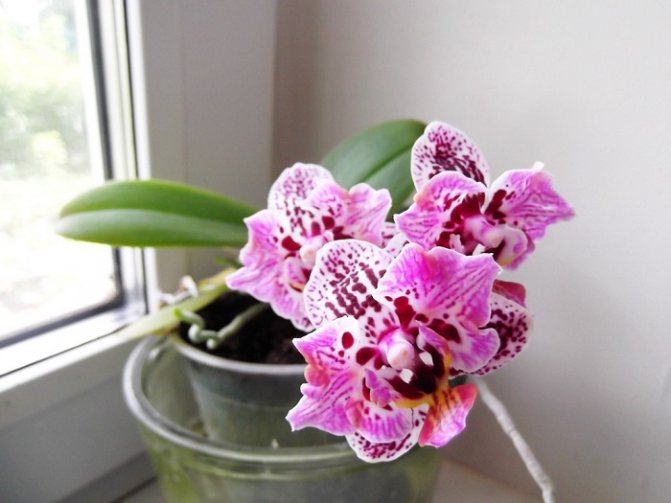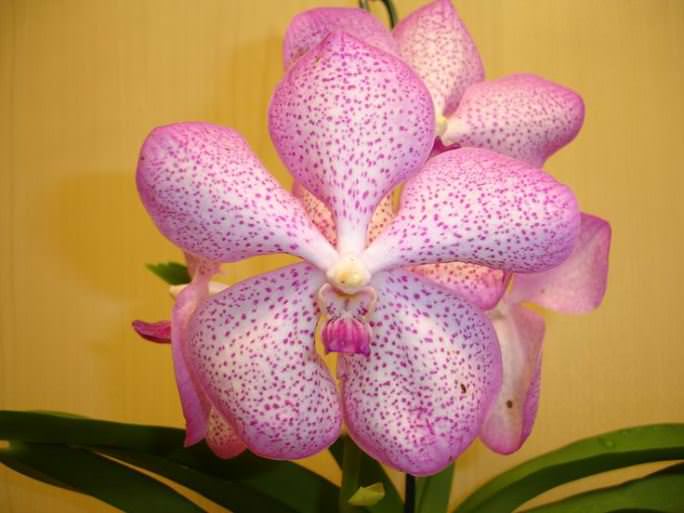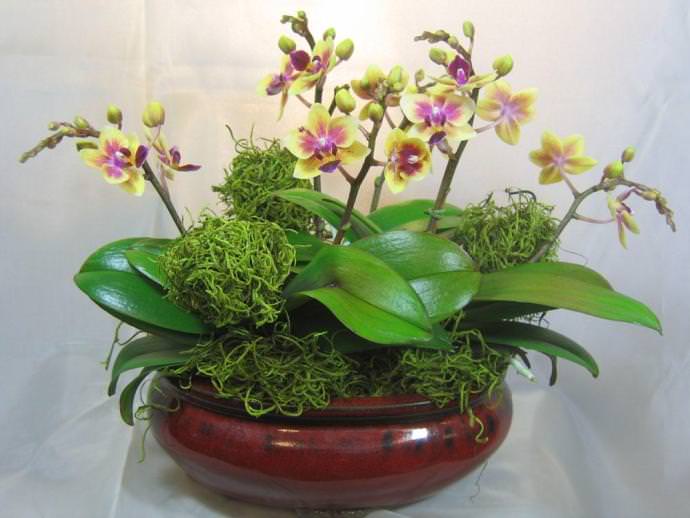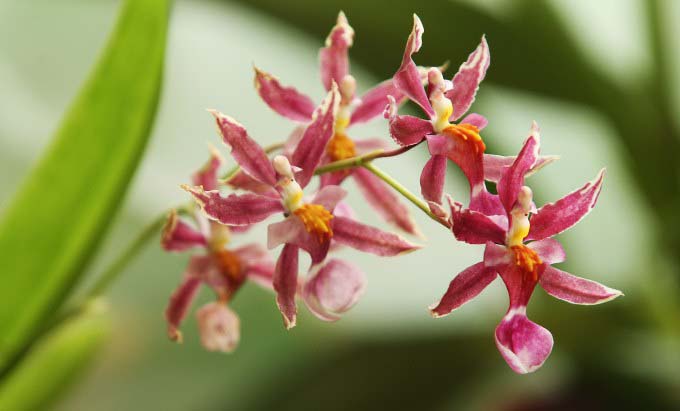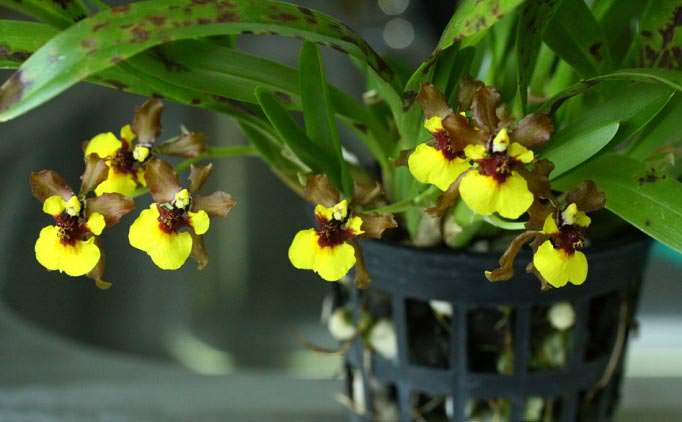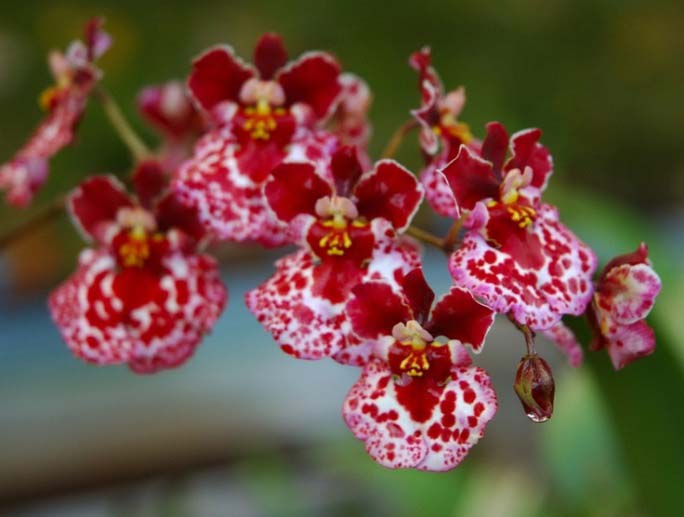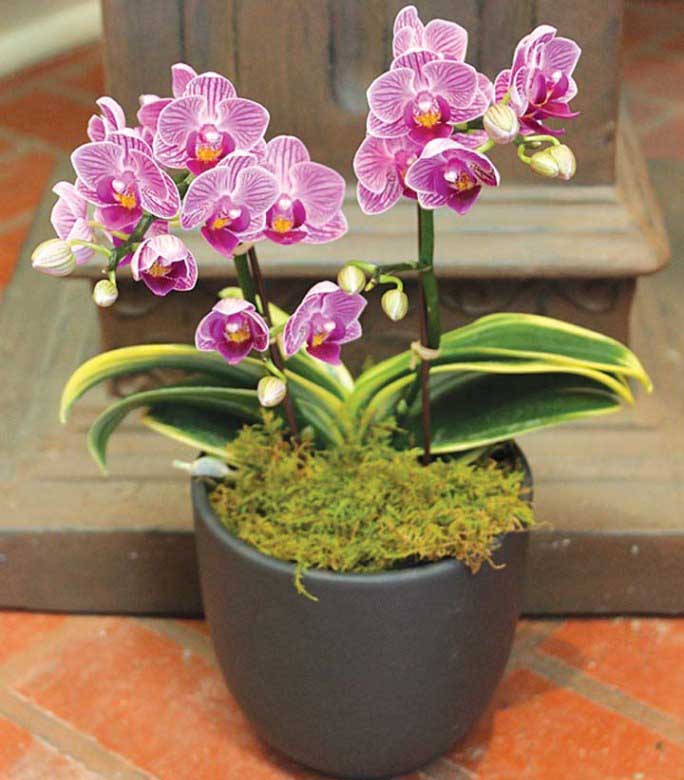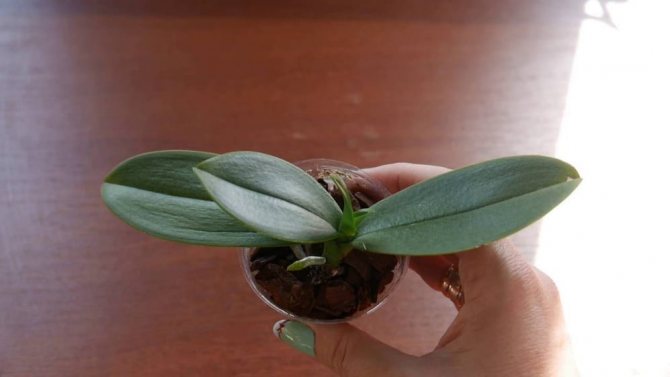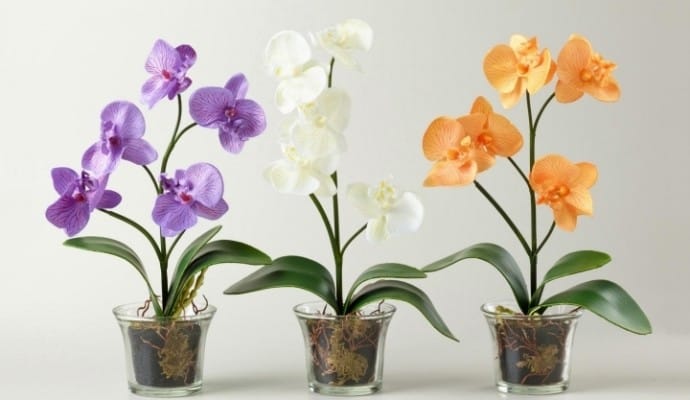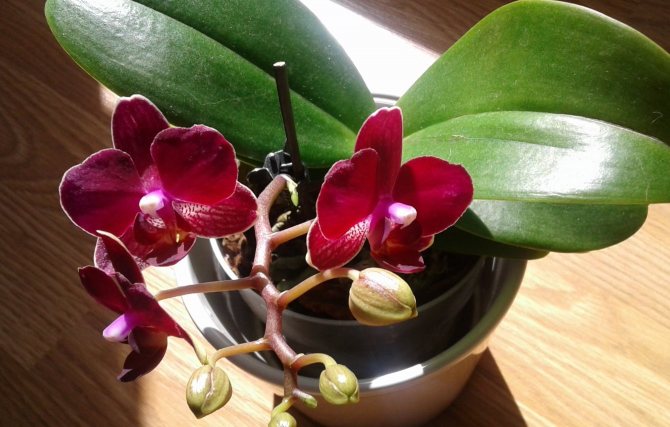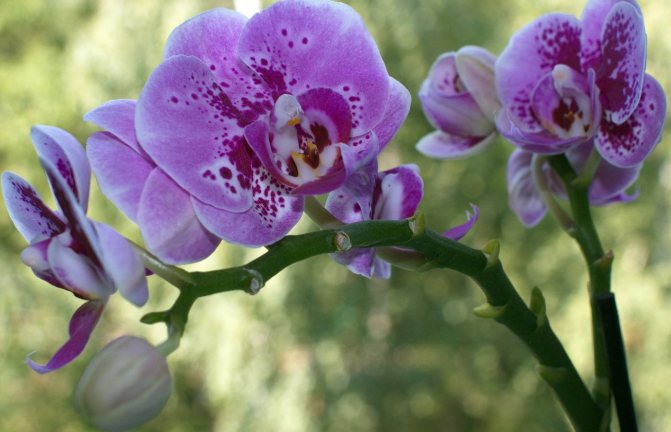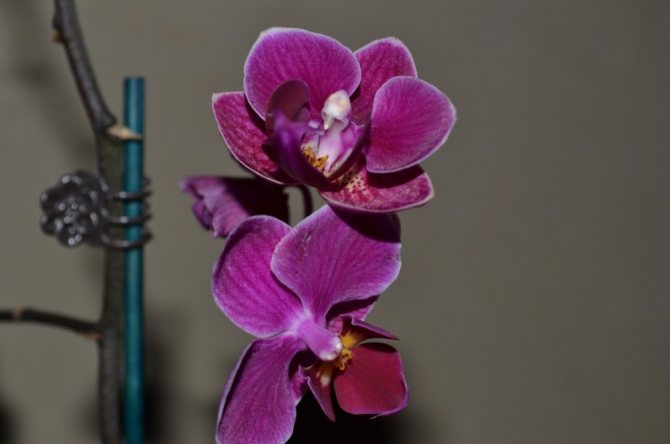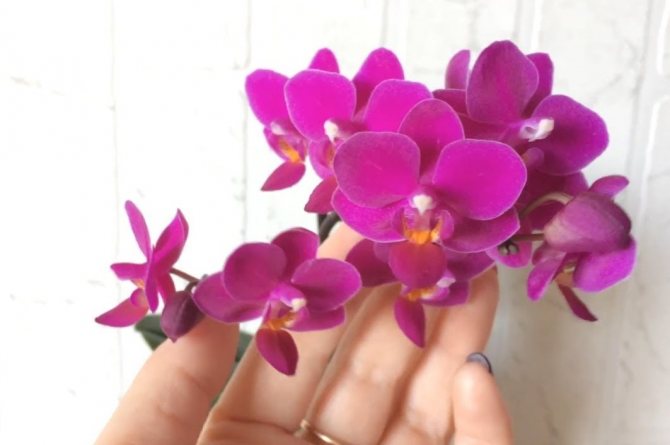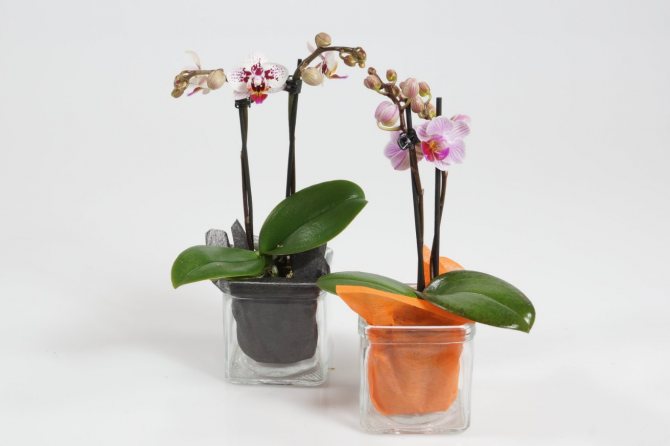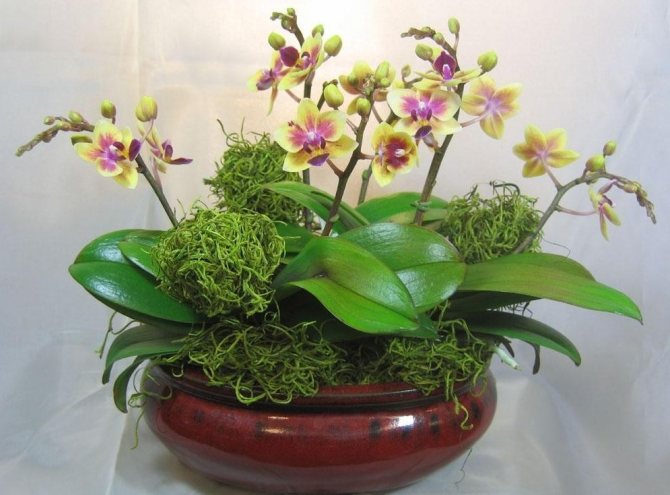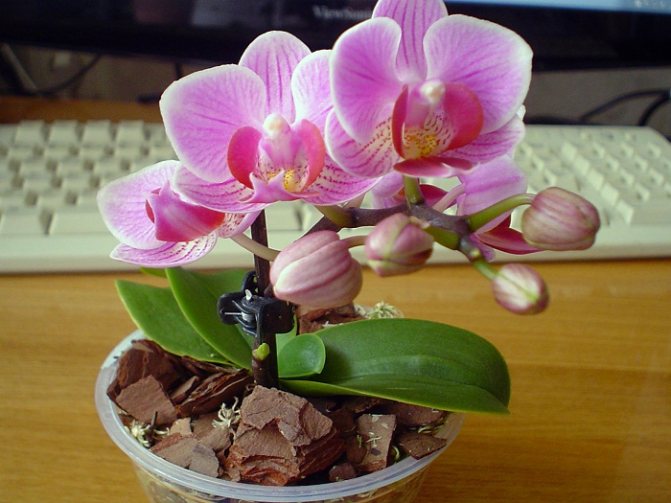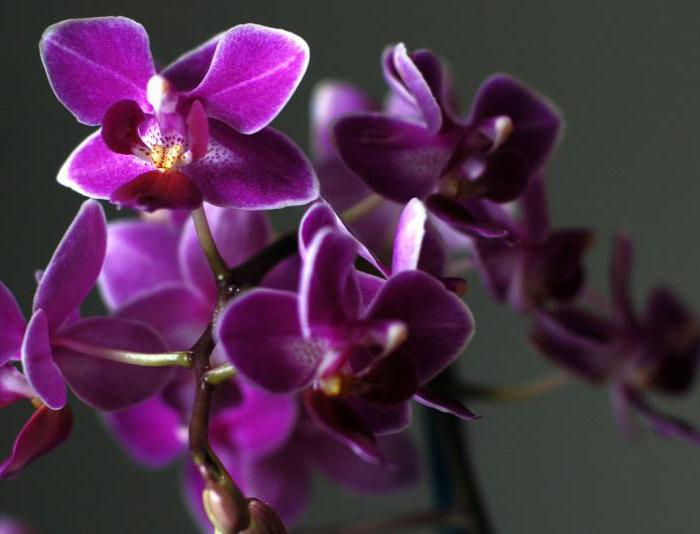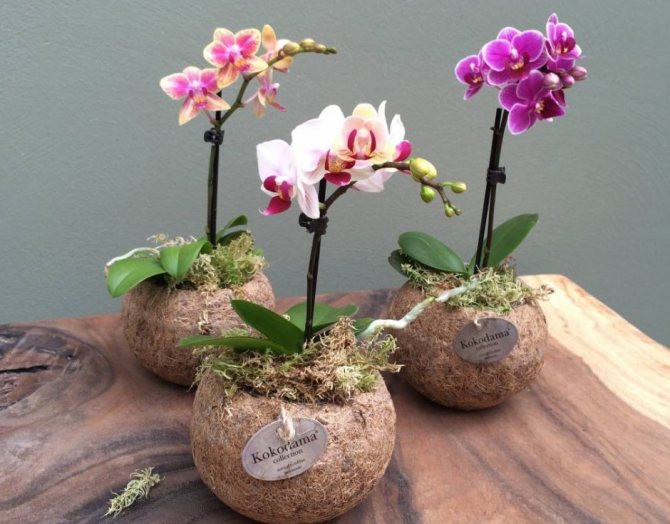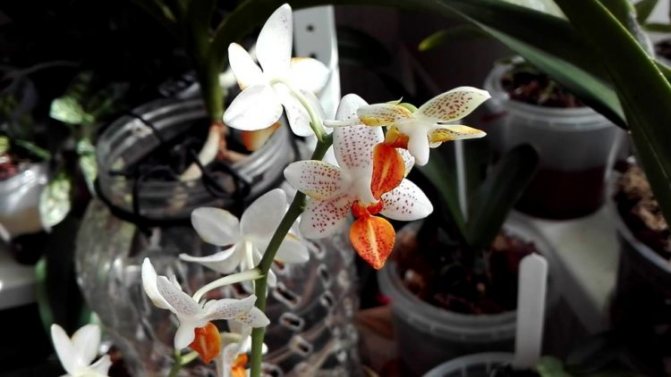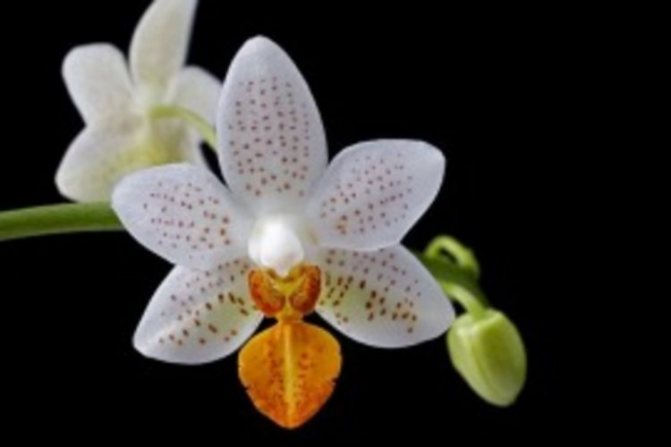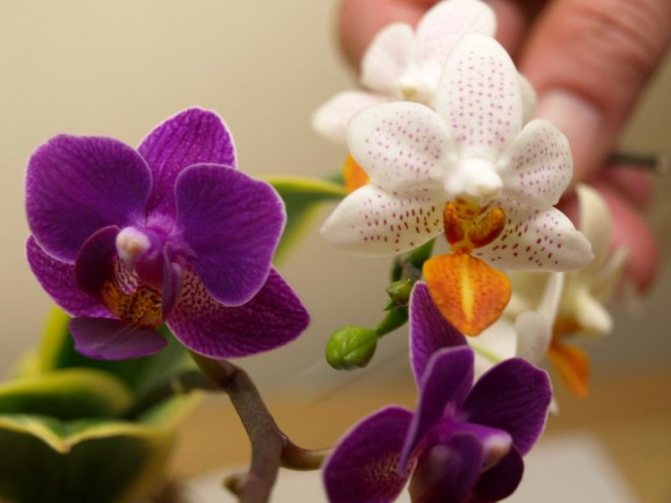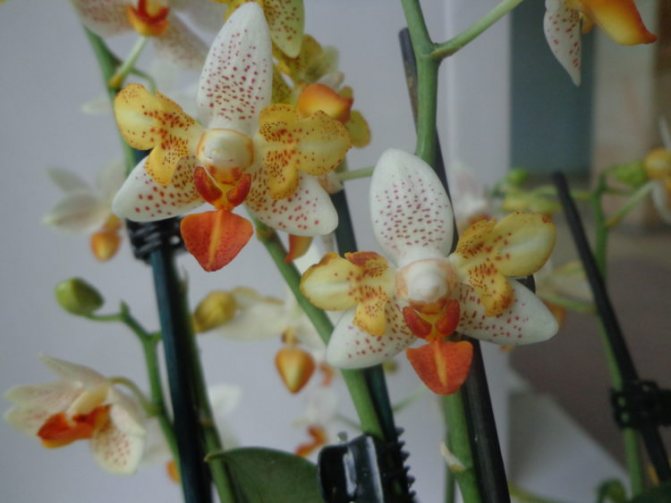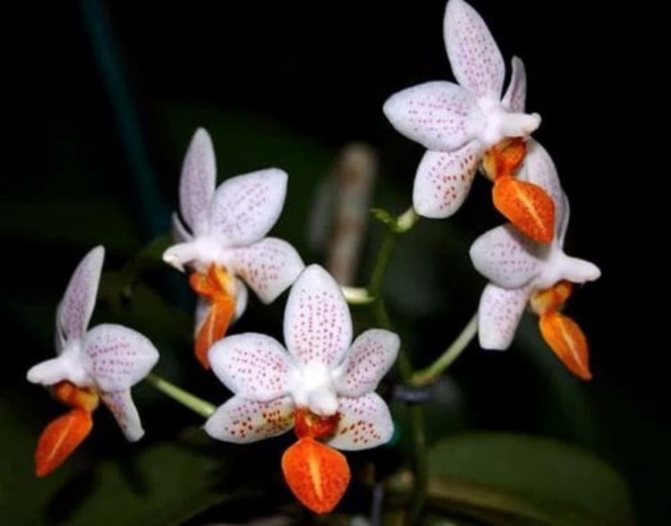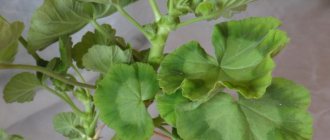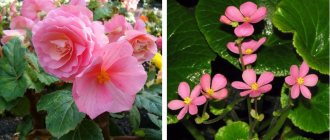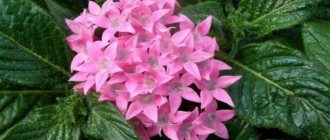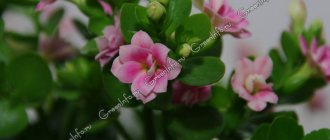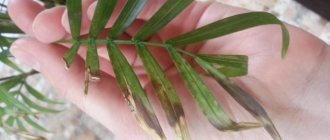Orchid is a tropical flower that can be kept in your home garden. Florists are attracted by the variety of flowers and the unusual appearance of the plant. Caring for the phalaenopsis orchid at home requires some knowledge, but even a beginner can grow this plant on his window. To preserve its health and beauty, it is enough to follow certain rules, as well as regularly water and feed in a timely manner, in order to enjoy flowering again and again.
- 2 Signs and superstitions associated with the orchid
- 3 Flower as a gift: care instructions
- 4 Landing: step by step instructions
- 5 Plant care
5.1 Fertilizers
What is this view, what does it look like?
Phalaenopsis Mini Mark is a hybrid variety of miniature orchid varieties bred in greenhouse conditions... The variety is compact, grows up to 20 cm in height. The leaf plate is elongated, bright green in color. The leaves grow up to 10-15 cm long. The flowers themselves are small, graceful, up to 3-4 cm in diameter. The petals are variegated - white with small dotted blotches. The specks can be of different shades - yellow, pinkish, orange. The lip is bright orange, contrasting against the background of the petals.
Important: With proper care of the Mini Mark orchid at home, flowering is long, lasts from autumn to mid-winter.
The variety can be purchased only in specialized stores or ordered via the Internet.
We recommend watching a video about the features of the appearance of the Mini Mark orchid:
Advantages and disadvantages of phalaenopsis mini
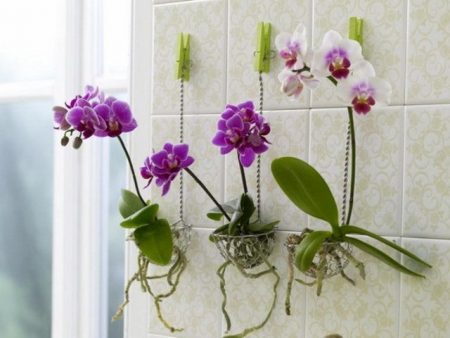
The advantages of this type of orchid include the fact that flowering lasts for two to three months, because the formation of young flowers occurs on old peduncles. In addition, the flower gives new arrows all year round. Another advantage of mini phalaenopsis is that it tolerates well the temperature conditions created in city apartments.
Among the disadvantages of this indoor plant, it should be noted that home flower care is complicated by the lack of sunlight, which is extremely necessary for such an exotic flower that comes from the tropics. In the natural environment of the plant, the light intensity remains unchanged regardless of the season. For this reason, when growing in an apartment, you must try to create the same conditions. An orchid needs twelve hours of daylight. Since there is no such natural light in the middle lane, especially in winter, Phalaenopsis needs to provide additional lighting.
History of origin
Phalaenopsis Mini Mark is a hybrid, the result of several crosses, bred at the end of the 20th century.... The hybrid variety "Micro Nova" was originally developed in 1980 by Henry Velbrunn. His followers - "Mini Mark", "Luddemana" were obtained by crossing the original hybrid "Micro Nova" with the natural variety of Phalaenopsis Mini Mark.
Orchid sub-varieties have gained widespread popularity and received many awards. The brightest representatives are clones "Timothy Christopher", "Cassandra", "Brother Pico Polo" and others.
Mini Mark
Phalaenopsis, easy to maintain. Has a variety of cream colors. The petals are decorated with orange and pinkish blotches.The lip has a rich orange hue. The leaves and stems are very neat and have a grayish-green tint.
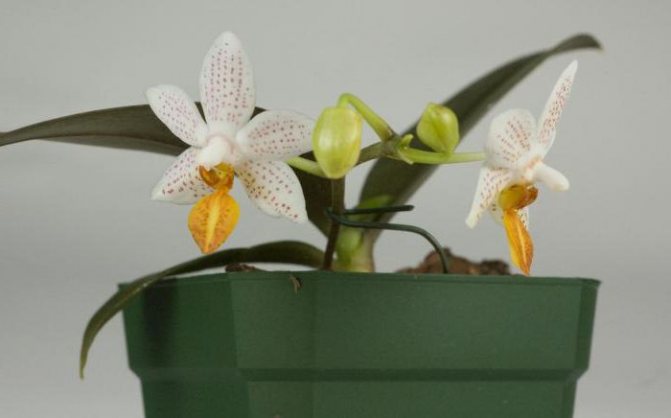

Separately, it should be said that this phalaenopsis will delight its owner with two flowering per year. The flowers themselves have a pleasant aroma. The leaves of the plant reach a length of no more than 12 cm.The flowers are about 4 cm in diameter.
Are there sub-varieties?
This hybrid is widely used in home floriculture; sub-varieties of this variety can be found in botanical gardens and greenhouses. The most common varieties can be considered: Mini Mark "Ostrovok", "Holm".
Miniature flowers do not have a pronounced aroma. Mini Mark "Maria Teresa" is distinguished by an exquisite floral light aroma... The flower is especially fragrant when exposed to sunlight. Mini Mark with flowers of a peloric shape are distinguished by the decorative irregularity of the petals themselves. Feature - buds at the beginning of ripening have a yellow color, then turn white.
general characteristics
This group of orchids includes epiphytes that grow in the tropical forests of the equator, as well as lithophytes that naturally live on rocks. Such plants become an ornament for the decoration of various camellias and malachite boxes.
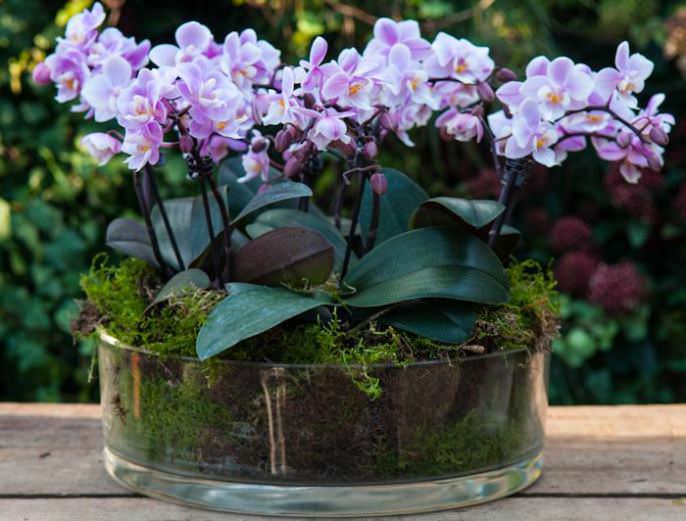

Amateur flower growers are partial to miniature plants and fell in love with mini-orchids for their compactness, as well as abundant and long flowering. In addition, the babies are distinguished by their bright colors and unpretentious care. However, one should take into account the fact that many of these indoor plants need special conditions that must be created for a normal existence in a living room.
A small orchid can become a great decoration for almost any interior. They look great in residential environments, as well as in offices and public buildings. So that the cultivation of such a plant does not cause difficulties, you should make the right choice of the type and variety, as well as familiarize yourself with the growing rules.
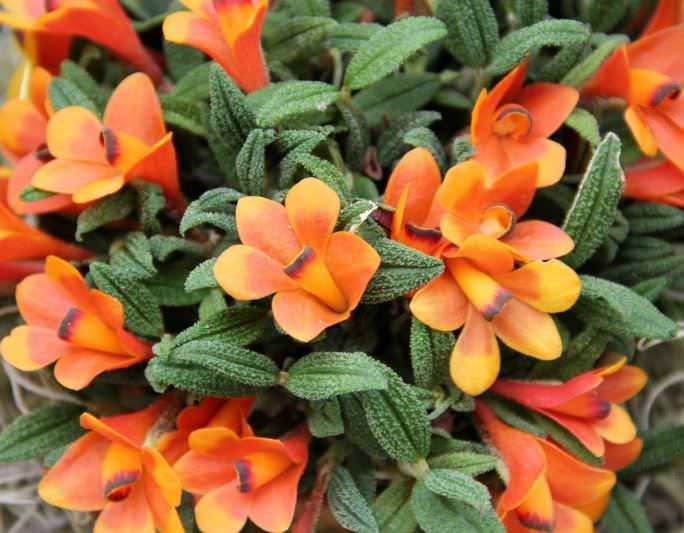

Home conditions
How to plant?
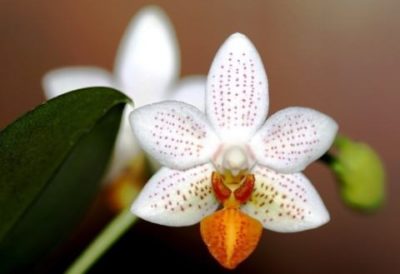

The Mini Mark Orchid at home requires careful care when planting... It is divorced only by the processes of lateral shoots or by "children" formed on the peduncles.
Landing scheme:
- The lateral new shoot is neatly separated from the mother flower.
- The shoot is transplanted into a container with moist bark for rooting.
- After 3 - 4 days, new roots appear.
- Peduncles grow after 2 - 3 months.
- With proper home care, the Mini Mark orchid buds begin to ripen after 10 to 12 days.
Attention: The phalaenopsis root system develops rapidly.
Care
Light and place
Direct exposure to the sun should be avoided. The variety prefers bright, diffused light. Distant lighting is acceptable. The pots can be installed on any windows except the north side. In summer, light shading of the southern windows is required to avoid sunburn of the leaves..
From the strong sun, white, dry, depressed spots appear on the leaves. Leaves may turn black.
Air humidity
Optimum air humidity for Mini Mark is at least 60 - 70%... With insufficient air humidification, the development and growth of the flower slows down. Flowering is problematic. Peduncles may not release buds. To increase humidity, place open containers of water next to the pots.
You can install the pots on wet expanded clay. To prevent the roots from sticking, the pots are placed on a grate, and then on a damp surface made of expanded clay or fine gravel.
In the autumn-winter period, excessive moisture should be avoided. Regular airing of the room, damp stagnant air is contraindicated in the thermophilic orchid Mini Mark.
Temperature
Mini Mark prefers a warm, humid climate. The optimum daytime air temperature is 18-25 ° C.The night temperature should be reduced by a few degrees.
Watering


Varieties planted in moss require frequent watering with minimal doses. Moss retains water well... Florists recommend watering the substrate with a tablespoon under the root so that the water is evenly distributed over the surface of the substrate. In the summer you need to water every 2 to 3 days.
Watering is possible by immersing the pot in a container with clean, settled water. After watering, the water should drain completely, and excess water should be poured from the pan. Stagnant water provokes the appearance of pathogenic bacteria. It is also recommended to spray the flower 2 times a day in the summer. Spraying is best done in the early morning and after sunset.
The substrate should dry out between waterings. Dry roots are silvery. Bathing the flower in a hot shower is recommended... Water temperature - up to 35 ° C. After the shower, you need to remove the water from the sinuses of the flower and the growth point with a cotton swab. Water stagnation in the core is unacceptable.
Top dressing
Mini Mark needs regular mineral fertilizing every 10 - 14 days during the period of active growth. At rest at home, an orchid grafting implies feeding once a month in order to avoid depletion of the substrate. It is necessary to strictly observe the dosage and feeding regime.
Fertilization can be done through spraying. For this, fertilizers are diluted with water, according to the instructions. Complex special fertilizers for orchids are usually used.
Reproduction
Hybrid varieties of orchids at home, with proper care, reproduce only by dividing... Sowing seeds is possible in greenhouse conditions.
Sprouts - babies appear with sufficient air humidification, at least 75% and an air temperature of at least 25 - 27 ° C.
Transfer
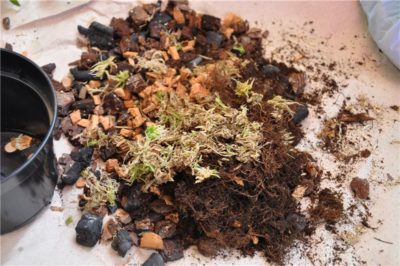

The plant should be repotted every 2 - 3 years, when the roots have grown strongly, the pot has become small... Also, a transplant is desirable immediately after buying a flower. Temporary containers and soil composition are not suitable for the permanent "residence" of the Mini Mark.
Soil mix for replanting:
- Pine bark - 1 tsp
- Coconut chips - 1 tsp
- Moss sphagnum - 2 tsp
The containers must be transparent so that the roots can be seen. The diameter of the pot should be selected according to the volume of the root system.... For adult flowers, the diameter of the container is 12 - 14 cm. Drainage holes should be made over the entire surface of the pot and at the bottom. The root system develops only with good air ventilation. Before planting, the pot is washed well, treated with disinfectants.
Transplant procedure:
- The flower is carefully removed from the pot.
- The root is cleaned of old, damaged dry shoots.
- Places of cuts are sprinkled with charcoal.
- The roots are dried before planting for 3-4 hours.
- The flower is immersed in a pot, covered with a ready-made substrate.
- The substrate is not compacted.
- The seedling is well moisturized.
Advice: The adaptation period can be painful. The flower looks wilted for several days. Mini Mark growing on a moss bed is best replanted every year. The transplant is carried out in the spring or immediately after flowering.
We recommend watching a video about the Mini Mark orchid transplant:
How to transplant a mini orchid (video)
Together with indoor miniature orchids, it is good to plant small types of ornamental plants, which can be represented by moss, selaginella, biophytums, gelksina, clover and sour. Such plants will not only serve as a decoration for a flower pot and basket, but will also help create a special microclimate that is beneficial for the orchid. These variants of satellite plants consume excess moisture and serve as a kind of indicator for watering.
Features of the
- Before flowering... If flowering is delayed, the plant needs additional stimulation.The flower should be placed in a cooler place with an air temperature of 15-16 ° C. You should also increase the humidity of the air. Without optimizing the conditions of keeping, flowering is problematic, the variety may begin to degenerate.
- Bloom... The Mini Mark variety can produce flower stalks at any time of the year. Flowering most often occurs from late autumn to early spring. For flowering, a temperature difference of at least 3 - 4 ° C is required. Frequent watering.
- After flowering... Immediately after flowering, the peduncle is completely removed. During this period, an adult flower can be transplanted. Top dressing is moderate.
General description of plants
Mini-orchids, which are often called dwarf or miniature, belong to the group of decorative flowering herbaceous plants. In their natural environment, these pretty flowers grow among the rocks and in the vast wooded part of the equator.
Not every grower manages to meet mini-orchids in our flower shops, more often they are brought to order. However, as you know, demand creates supply. As a result of the growing popularity of miniature herbaceous plants of the Orchid family, sellers of flower shops and horticultural shops began to expand their range.
What is the reason for such a high interest of flower growers in these herbaceous crops, you ask? The main advantages of mini-orchids are called long flowering, an abundance of color palette and, of course, compactness. The height of an adult flower during the flowering period ranges from 15 to 30 cm.There are also more miniature specimens, the height of which does not exceed 10 cm.


Diseases and pests
Mini Mark is sensitive to any disturbance in temperature and humidity. An orchid, with improper home care, is susceptible to diseases, fungal viruses.
Possible illnesses and difficulties:
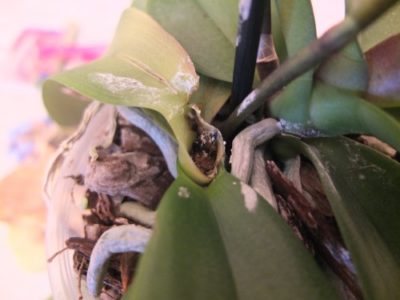

From excessive watering, stagnant water in the pan, dampness of the substrate, root and stem rot appears. The root becomes slimy, dark, takes on a brown tint. Leaves lose their shine and firmness. An urgent transplant is required, replacement of the infected substrate, sanitary pruning of damaged fragments. It is necessary to process the flower with a foundation.- From too much watering and too bright light, the leaves turn yellow. Watering should be weakened, the pots are rearranged in a darkened place.
- Leaves fall off from overdrying of the substrate and insufficient air humidity. It is necessary to moisten the soil, increase the humidity of the air through spraying. It is necessary to shade the place where the flower is kept.
- The leaves and growing point are blackened - viral rot. Insecticide treatment required. In case of severe damage, a flower should be transplanted.
- From a spider mite, the flower should be treated with phytoverm. A hot shower will also help.
- Spraying with karbofos will relieve the flower scabbard and mealybug. Prophylaxis is carried out 2 - 3 times with an interval of 6 - 7 days.
- The appearance of slugs. Disinfection of the pot and treatment of the substrate with foundation is required.
We recommend watching a video about diseases and pests of orchids:
Flower as a gift: care instructions
If the flower was donated, then some care will be required to preserve it. It is necessary to transplant the plant, since pressed moss, foam rubber and peat are used as gifts for gifts. Such a pillow leads to waterlogging of the root system and its rotting.
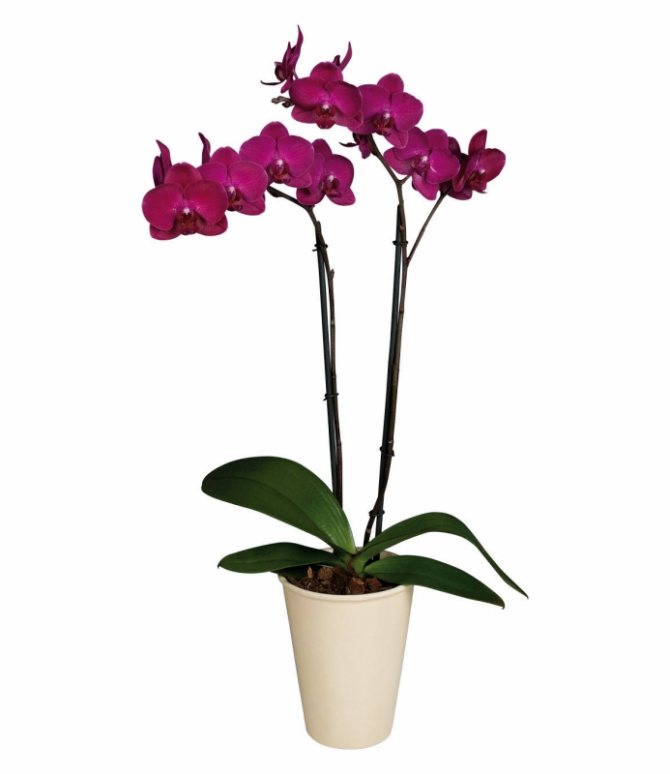

The flower should determine its place in the house, since it does not like movement and rearrangement causes severe stress. The pot should be placed in a bright and warm place. 7 days after transplanting, the flower is watered for the first time. This is done very carefully, water is poured along the edge of the pot, and the excess is drained from the pan.
For the first month, the plant should be kept away from others, as it can be infected.
Can I keep it outdoors?
Keeping the flower outdoors is not recommended... Exot is not grown in our climatic conditions in the open field.
You will find the characteristics and features of growing other varieties of orchids - Cumbria, Zygopetalum, Oncidium, Caoda, Multiflora, Wanda, Cattleya, Sogo, Vanilla and Dracula - in our separate articles.
Signs and superstitions associated with the orchid
A tropical flower enmeshes many signs and superstitions. Some believe that keeping an orchid in the house is strictly forbidden, others are convinced that it is a strong amulet and talisman.
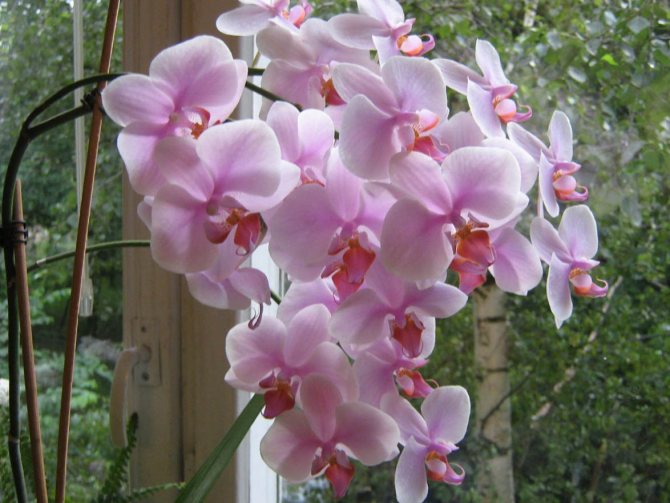

Folk omens say that a plant cannot be kept at home, since it is a vampire and sucks out all the vitality of the household.
It is believed that the orchid consumes masculine energy, which forces them to leave the house. Men become weak, sickly, do not want to work.
The flower has positive aspects. If you take proper care of the plant, then it will give the household members love, harmony and prosperity. The orchid causes negative emotions and poor health in bad people, therefore it is considered the protector of the hearth.
Choosing the right container and soil
Unlike ordinary orchids, dwarf flowers need special soil. Large plants grow well in the crushed bark of coniferous trees, as well as in a special substrate with a large number of constituent components. For small orchids, a special soil is selected. The composition of the soil can be as follows:
- Sphagnum moss;
- Shredded charcoal;
- Very fine pine bark.
In the presence of the last two components, the liquid does not stay in the substrate, which helps to avoid decay of the root system.
The flowerpot should be small and match the size of the small flower. You can make a container with your own hands using a small bowl with several holes in the bottom and on the walls.
Scientific and consumer classification
To make it easier for you to understand further reasoning, let us first introduce you to some terms in the taxonomy of orchids.
You probably know that all species, varieties and hybrids are subject to official registration and classification based on pedigrees. On the one hand, such a strict scientific classification helps to quickly navigate the names, but in practice it is often inconvenient to use it.
Are there blue phalaenopsis
Therefore, the so-called consumer classification arose, in which all phalaenopsis varieties were divided according to the type of flowering. There are 3 main groups:
1. Standard. After flowering, the apical bud of the peduncle dies off. The peduncle is long, the flowers are large (9-12 cm), and are located in its upper part. The genes of such species as Phalaenopsis stuartiana, Ph. schilleriana, Ph. amabilis and others close to them.
How do orchids grow?
2. Novelty. In this group, the peduncle grows many times from the upper bud after a dormant period. Small flowers (4-8cm). The shape is usually correct, the petals can be ovoid or pointed. Novelties are further subdivided into 2 subgroups: classic and modern. The classical pedigree consists only of natural species of the subgenus Polychilos. In modern ones, in addition to orchids of the subgenus Polychilos, there are also standard phalaenopsis in the pedigree.
3. Multiflora. In plants of this group, the peduncle grows during the flowering process. It tends to branch out. The flowers are quite small (3-6 cm) and often in large numbers on one peduncle. In most cases, their shape is the same as that of standard varieties. The cells of these hybrids are dominated by the genes Phalaenopsis schilleriana and Ph. stuartiana on one side and Ph. equestris on the other.
Reproduction at home: how to get a stalk or baby
Phalaenopis has children on the peduncle. The bud throws out leaves, and then aerial roots appear on it. Only after the appearance of aerial roots can the baby be planted.
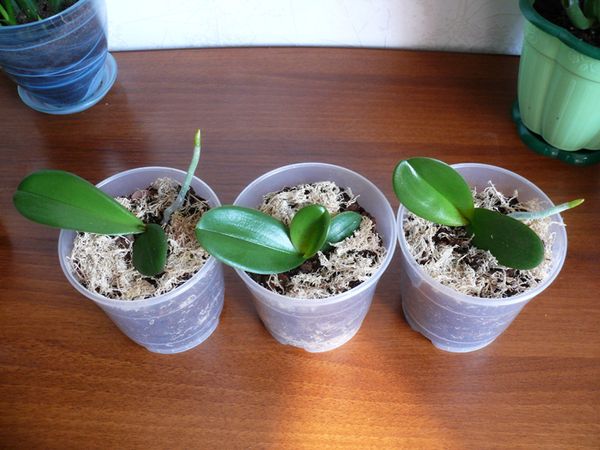

The baby, planted with a part of the peduncle, is planted in a separate pot
The baby is cut off with a part of the peduncle and planted in a separate pot, the aerial roots are left on the surface.
You can also propagate an orchid by cuttings. After the orchid has bloomed, with a fat-free knife the peduncle or lateral shoot is cut off. Divide it into parts so that there is a kidney in the middle of each.
For bud germination, greenhouse conditions are created: cuttings are placed on wet sphagnum moss, covered with plastic or glass dishes and placed in a warm place. The sprouted stalk is planted in the ground with the cut down.
Most a rare method in use - dividing the socket... Suitable for large adult orchids with 6-8 leaves. Cut off the top of the plant with 4-5 leaves and aerial roots. The resulting shoot is planted in a new pot.
Phalaenopsis can also be propagated using seeds. But due to their tiny size, this is a laborious process and only possible in the laboratory.
Conditions for successful growing at home
For the good development of miniature orchids, they need to organize comfortable conditions and carefully monitor the lighting, temperature indicators, and air humidity.
Seat selection
Creating optimal living conditions for a mini-orchid begins with choosing a suitable place for it. Phalaenopsis prefers to settle in dark places with diffused, non-aggressive light. The plant has a negative attitude to direct sunlight, and also reacts negatively to the presence of drafts.
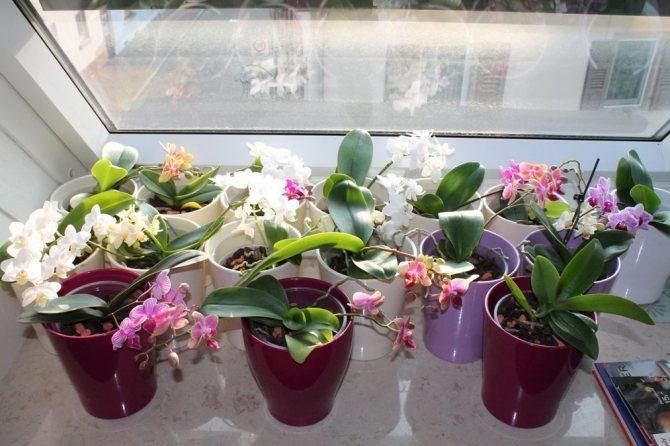

Window sills on the east or west side of the apartment are considered the most optimal place for planting an orchid. When the flower is located on the south side, it needs to be darkened using a special grid.
Temperature and humidity
One of the important factors affecting the full development of a mini-orchid is the room temperature and humidity. Experts recommend maintaining all-year-round temperature indicators in the range of + 18 ... + 25 ° С, while the difference between night and day temperatures should not be more than + 3 ... + 4 ° С. It should be noted that sharp jumps in temperature can cause sticky, transparent secretions to appear on the foliage and flowers of the culture, which are often confused with symptoms of pest infestation.
Did you know? The first hybrid phalaenopsis, obtained by crossing two species of this genus, was bred by breeder John Seden in 1875. This orchid did not begin to bloom until 1886.
In summer, a slight increase in temperature parameters up to + 30 ° C is allowed. In winter, you need to ensure that the temperature does not fall below + 15 ° C. Mini-phalaenopsis prefers to grow in conditions of an average humidity of 40 to 50%. High humidity can provoke rotting of the root system and the formation of dark brown spots on the leaves.
If the air is too dry, the flower will begin to dry and shed the leaves. To ensure the desired level of humidity, it is recommended to place open containers with water near the pot with the orchid, or to install decorative, artificial fountains, and an aquarium with fish.
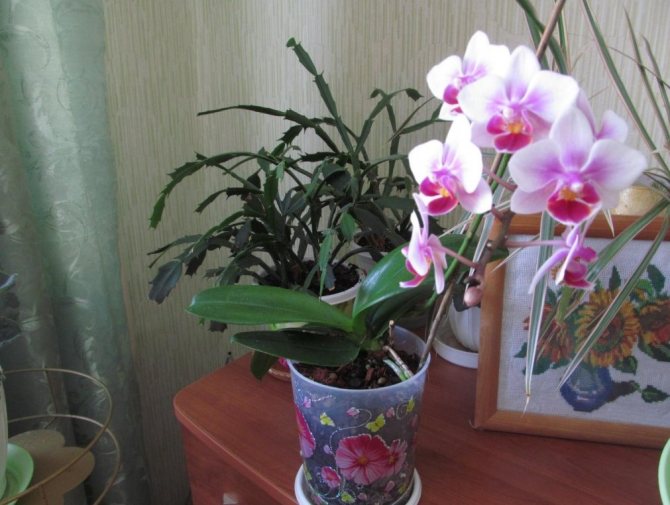

Watering orchids on a moss "pillow"
These need to be watered more often than those growing in the bark, but less water is needed.
Moss has a higher moisture capacity than bark: it absorbs 25 times more water than it weighs. This is achieved thanks to empty, unclosed cells that fill with liquid in a short time.
So watering a mini-orchid growing in moss by immersion or spilling is fraught with too high moisture in its soil.
So here it is recommended to spray the ground a couple of times a day. Well, or pour from a spoon - from the dining room or tea room, depending on the size of the pot. This amount of water will dissipate throughout the moss in a short time.
In case of prolonged irrigation of an orchid for several days, its leaves become slightly wrinkled. Then the plant must be watered using any of the methods described above.If the reason for the wrinkling was precisely the lack of irrigation, the shape of the leaves will be restored.
But if it does not recover, it means that the roots of the plant have died. Then it is necessary to urgently carry out its resuscitation and build up a new root system.
What problems can you face
If the leaves of a mini-flower have lost their smoothness, they began to become covered with wrinkles, this may indicate that the orchid does not have enough moisture. Try to water your orchid properly. If the leaves became smooth and elastic again, the problem was precisely the wrong watering.
Leaves can lose elasticity and firmness even when root diseases begin. With insufficient watering, the roots dry out, and with abundant watering, they rot. The leaves do not receive the necessary nutrition, they begin to dry out, turn yellow, become lethargic and lifeless. In this case, it is necessary to reanimate the houseplant.
If a small orchid does not bloom, there may be several reasons:
- Lack of sunlight;
- Improper room temperature;
- Too strong and frequent drafts;
- Dry air;
- Improperly selected fertilizing with a high nitrogen content.
Dormant period
Mini-orchids differ from other orchid species in something else: the absence of a dormant period in wild-growing specimens. They can bloom equally well all year round. They could also in room conditions - but in winter too little light does not allow them to fully bloom, so they have to fall into a state of rest at this time.
In winter, he can and should be helped by adding light. Moreover, not ordinary bulbs are recommended, but special phytolamps with blue and red colors, which are most suitable for indoor plants.
Top dressing for orchids growing in the bark
For a mini orchid to bloom better, it needs to be fed. The procedure is recommended to be carried out during the growth period, while applying fertilizers specially produced for orchids. But do not overdo it, otherwise cracks will appear on the leaves. And before using this or that drug, you should carefully read the attached instructions.
Mini-orchids need feeding all year round, once every 2-3 weeks. To do this, you should use special preparations sold in any store specializing in flowers. Feed this way: lower the pot in fertilized water, keep it there for a few minutes, and then remove the pot and drain the plant over the soil.
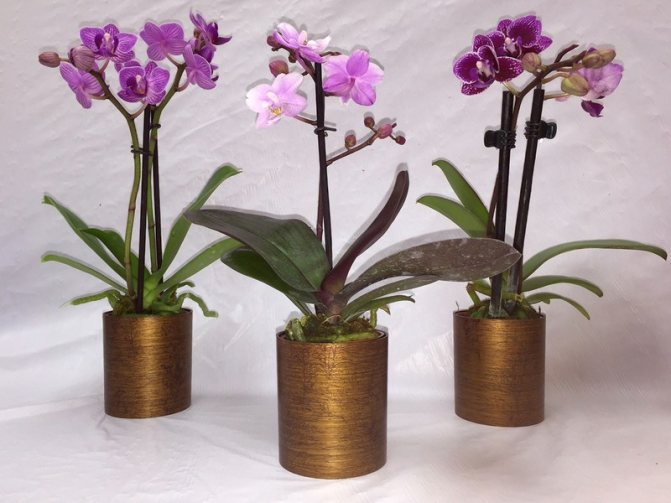

Top dressing of orchids on a moss "pillow"
Due to the nature of the soil, mini-orchids growing on a "cushion" of moss need to be fertilized in a different way than other plants. They need to be fed once every one and a half to two weeks when they are actively growing, and not more often than once a month, but better - without it at all, during a dormant period. The latter takes place in the hottest summer and in the darkest autumn-winter months.
It is allowed to feed these flowers by the foliar method, "on the sheet". This is when a quarter of the indicated dose of top dressing is thickly diluted in water, and the leaves of a houseplant are sprayed with this solution. This feeding method is just amazing for spray irrigation and is safe for roots that are sensitive to fertilizer salts.
The rest of the feeding rules for mini orchids are the same as for any other orchid species.
Miniature orchids of the genera Promeneus and Psychopsiella
Promenaea Lindl. - Exchanging.
A genus of epiphytic or lithophytic orchids from Brazil, including 19 species. Representatives of the genus live in humid low-mountain tropical forests, grow on rocky slopes, butt parts of trees. All promenades are small sympodially growing orchids with convex pseudobulbs hidden in the bases of leaf sheaths and with single flowers up to 5 cm in diameter.
In culture, the exchange of golden yellow (P.xanthina (Lindl.) Lindl.) and stapeliform (P. stapelioides (Link & Otto) Lindl.). All species of the genus require moderately warm maintenance (winter night temperature 14-16 ° C), moderate diffuse illumination and high relative humidity (80%).
Preferably kept in small mesh pots or baskets.
Psychopsiella limminghei - Psychopsiella Limming.
The only species of this monotypic genus lives in the rainforests of Brazil and Venezuela. Miniature epiphytic orchid with small flattened pseudobulbs up to 2 cm long and rather large flowers compared to the plant itself (3-4 cm in diameter).
Petals and sepals, blunt at the ends, brownish-orange or rufous, with light spots. The dorsal sepal is concave. The petals are reddish brown with a yellow border around the edges. The lateral lobes of the bright yellow lip, also covered with numerous reddish-brown bright stripes and spots, are narrow at the base and widen into vertical ears.
The anterior lobe of the lip has a narrow isthmus and can be directed upward or slightly curved. The column has ridge-like wings. The maximum flowering occurs in the summer months - from May to September, but some flowering plants can be found in late autumn and early spring.
Needs a moderately warm or moderate growing regime, diffused illumination (18000-25000 lux) and high humidity (75-80%). It does not tolerate stagnation of water near the roots, so in winter, watering is slightly reduced. Prefers block culture and regular spraying.
Photo
Further you can see the photo of the Mini-Mark orchid:
Difference from other species


Mini Mark is a thermophilic orchid that requires an air temperature of 18-27 ° C. For the Mini Mark to bloom, it needs a temperature drop of 3-4 ° C.
This variety does not require much moisture, but it has its own characteristics.:
- Mini Mark can rot at the point of growth. It is better to water the orchid by soaking the pot so that moisture does not get on the flower itself.
- But he does not like long drying out. Water more often than other mini orchids.
- This hybrid variety consumes more light, it just needs it for flowering.
Advice! Substrate for Mini Mark is prepared on the basis of pine bark. Plastic transparent pots are used, so it is easier to monitor watering and the condition of the roots.
What pots, soil are needed?
Important: For growing mini orchids, use special sphagnum moss or peat moss. At the same time, after purchase, many growers advise to divide the plants into their own pots, which, with their soil composition, have oak bark.
Moss retains moisture much longer than a regular substrate, so you should not do frequent watering of the plant, as this leads to rotting of its root system.
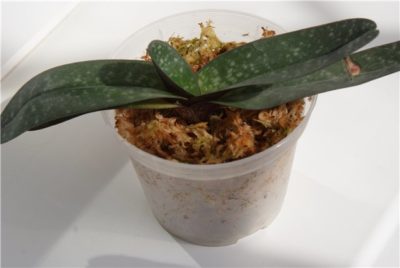

Plastic containers are usually used as pots, in which the orchid is bought.... Their size is from 6-8 cm in diameter.
This container can be placed in a glass or plastic pot that fits the interior, thus hiding it. Some varieties of mini orchids are grown suspended as they have rich clusters of flowers. At the same time, orchid pots should be transparent, this will provide better light access to the root system.
Some problems in growing
When growing such a plant, flower growers can face several problems. So, the question often arises, why does the Phalaenopsis mini orchid dry with proper and systematic care? Usually this ailment is associated with an excess of sunlight or waterlogging of the substrate. Wrinkling and darkening of the leaf plates, on the contrary, indicates a lack of moisture.
If the mini orchid does not bloom, then there may be several reasons. Every florist will surely find some flaws in the cultivation process. Lack of flowering is often associated with:
- lack of sunlight;
- the presence of drafts in the room;
- insufficient air humidity;
- an excess of fertilizers containing nitrogen.
Glass flower care
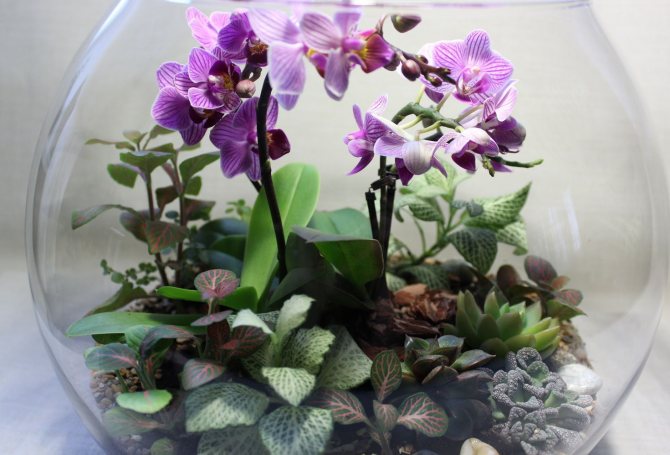

And what should be the care of a mini orchid in glass, which also takes place? The use of pots made of such material is permissible, but it has a number of features. In such a situation, a prerequisite is the use of drainage. It is poured into the bottom of the flowerpot, the layer thickness must be at least 3 cm. An additional plastic container is fixed on this "pillow". It is in it that culture will be contained. Then water is poured into the pots, the level of which should be slightly higher than the drainage. But for plastic containers, moisture should not get out. The attractiveness of this method of growing a dwarf orchid is that the water constantly evaporates, creating an optimal level of humidity.
Reproduction of a dwarf orchid
The process of reproduction of a dwarf orchid deserves special attention of flower growers. How does this happen in this type of plant? Usually the vegetative method is taken as a basis. In this case, a baby mini orchid is used, which is separated from the flower. When a new shoot appears, it is carefully removed. Then the planting material is immersed in a greenhouse that was previously prepared. You need to spread wet sphagnum in it. Usually, to get a full-fledged adult shoot, you need to wait, it takes about 1 year.
Many flower growers are concerned about the question of how to properly transplant a mini orchid after purchasing a flower. However, it is necessary to change the place of residence of the plant in subsequent periods. It is recommended to renew the container every 2-3 years, since the bark decomposes during this period. The soil loses the necessary air permeability properties. The root system of the flower receives very little oxygen and nutrients, which can ultimately provoke the death of the plant. A mini orchid is also transplanted if the pots are overflowing with roots.
Where is it recommended to start the process of changing the “place of residence” of culture? To begin with, it is worth preparing everything you need for the plant. For this reason, the question often arises as to which pot is best for a mini orchid. It is worth making a reservation right away that too large and spacious container is not needed. The container should be a little tight for the plant. This will ensure optimum soil breathability. The container must be transparent.
The subtleties of the process of transplanting mini orchids
When pots for mini orchids are selected, you can proceed to the very process of transplanting a dwarf orchid. It is recommended to start by removing the old substrate or moss. The root system of the culture must be thoroughly cleaned. For ease of removal of the soil from it, you need to immerse the flower in water for just a few minutes. When moisture saturates the moss or substrate, you need to carefully separate all excess from the roots.
Thinking about how to transplant a mini orchid correctly, you should pay attention to the condition of the root system. If some areas are affected by salinity, they should be removed. Aerial roots do not need to be directed into the pot. As for the optimal transplant time, it can be anything. The flowering process is not a reason for refusing to change containers and substrates. When all the preliminary work has been done, the dwarf orchid is immersed in a container and covered with new soil.
Many growers are interested in how a mini orchid is transplanted into a closed system and what features this process has. In this case, the container may not only be made of glass. Some growers successfully use plastic containers. The main feature of these pots is the absence of drainage holes. In this case, the soil will be represented not just by moss or bark. You will need to create a multilayer system.
Growing dwarf orchids in a closed system is usually used to resuscitate and restore damaged plants that have an injured root system.
As you can see, the cultivation and care of dwarf orchids, which are usually called mini, are quite diverse, but they are not impossible. If you pay enough attention to the plant, then it will delight you with abundant and long flowering. We advise you to see the article: How to care for clematis in the spring for good plant development?
Phalaenopsis transplant
Transplant the Phalaenopsis orchid only if absolutely necessary. The main reasons for the transplant are:
- the plant becomes cramped in the pot, the roots go out;
- decay of the substrate: decomposition of the bark;
- waterlogging of the plant.
The most favorable time for replanting is spring.
How to transplant - good step by step instruction
Phalaenopsis sometimes can be transplanted into the old pot, but you can also pick up a container with a slightly larger diameter.
Step 1. Preparing the pot... We fall asleep to the bottom of the drainage layer. Suitable for this: pebbles, shards of clay pots or pieces of polystyrene. Next, fill in a small layer of the substrate.
Step 2. Prepare the plant. Turn the pot on its side and carefully remove the plant. Clean the roots from the old substrate and rinse them with warm water. Cut off damaged dark roots.
In no case, do not cut off the airy fleshy roots that come out of the phalaenopsis.
Step 3. Fix the orchid in the soil. Place the plant in the middle and carefully cover it with substrate on all sides. Leave the roots that grew outside, also outside, they will die in the soil.
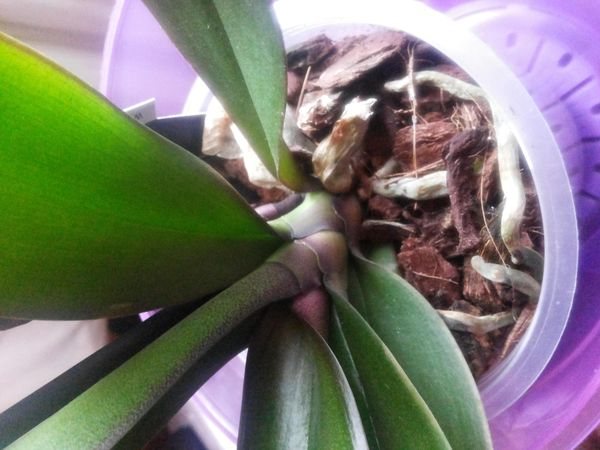

An example of an orchid placed in the center of a pot and compacted with substrate
Step 4. We fill up the substrate... The soil needs to be crushed a little, but not compacted. Tap the pot to help the soil settle and spread evenly.
Step 5. If necessary - tie an orchid to a bamboo stick.
After transplanting, move the plant away from direct sunlight. Keep watering in moderation and spray. After two to three weeks, you can return the plant to its usual place.
Testimonials
The owners' reviews are the most enthusiastic. A compact bush with large flowers is the pride in the collection of every orchid lover.
“I really like my mini phalaenopsis - they take up little space, bloom for a long time, and the size of the flowers is impressive! I comply with all the conditions, in general, it is not so difficult. They bloom steadily, they feel good. I periodically please myself with a new flower from the mini series, they are my favorites. "
“In my opinion, mini phalaenopsis are much easier to care for than all other orchids. The size of the flowers is especially impressive! Not every large species can boast of such. If someone hasn't tried it yet, I highly recommend it! "
Reproduction of orchids
The orchid reproduces vegetatively. The planting material (a small process) is separated from the flower.
For reproduction, the young shoot remaining after the flowering of the culture is immersed in the prepared soil. Wet sphagnum is a good option for germinating the material. A mini culture takes root within a year, so you cannot expect a quick growth of the offshoot. Roots are gradually formed in the root system, which, after a few weeks, are transplanted into a fertilized substrate.
Block growing
To create blocks, thick pieces of pine or larch bark, small pieces of wood are used. They can be found in the forest (bark removed from fallen trees), or in woodworking factories, as well as in shops selling orchids.
The plant is first carefully fixed on the block with fishing line, nylon thread or thin wire. When it grows to the block, the line is removed.
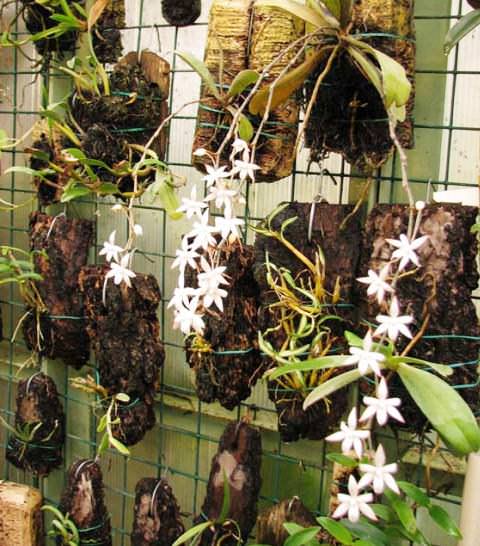

Block orchids are usually grown in glass orchidariums with artificial lighting.Or they build whole "flower windows" - a florarium is attached to an ordinary window in the house. Or simply in the window (you can opposite the balcony window) they attach a metal mesh with large cells, on which ready-made blocks are hung with hooks.

